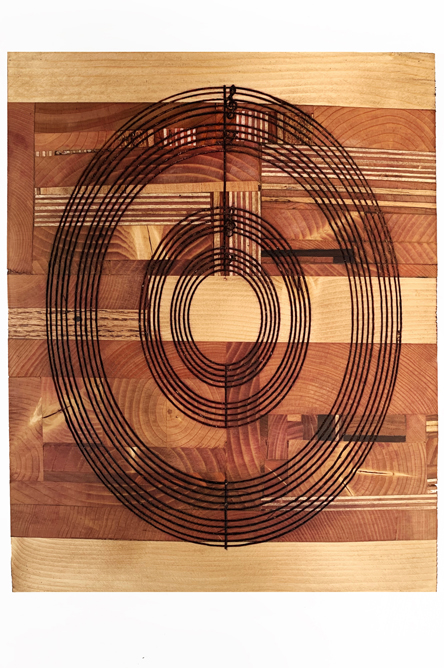
Sean Miller & Connie Hwang
- Artist
Biography
Sean Miller and Connie Hwang
The Music Conservatory for Termites (After Ben Patterson)
wooden music sheets, classical conductor's wand (made of museums small shelf), termite eaten metronome 2019-2020
This work is inspired by friend and Fluxus artist Benjamin Patterson's project: "Ants" (1960-2010). Patterson's project description states, "The story of this composition begins in July, 1960. Discovering an ant hill in a garden in Dusseldorf. I believe I had found a new approach to aleatoric music. I scooped-up a bunch of these ants, dumped them into the center of a sheet of paper and made 6 photographs over the course of 10 minutes... [later] I transferred these random dots (ants) to pages of blank music staffs."
We have adopted Ben's strategy and applied it to termites. For this project our "blank music staffs" are engraved into sheets made of a specially produced composite of various woods pulled from the architecture of an international array of museums, art centers, and galleries (collected by Sean Miller). The musical staffs are planned and designed by Connie Hwang and myself to relate more directly to tree rings visible in wood grain and the holes that termites produce.
Termites are routinely narrowly viewed by humans. The term "pest" is almost synonymous with "termite." However it is clear that it is the humans here that have the problem (not the termite). For instance, our negative view of termites is directly related to our centuries-old love of wood and houses. However, humans that look closely at termites realize they help our environment in changing plant and wood matter into new fertile soil. Entomologist Barbara Thorn calls termites "green machines" and theorist Timothy Morton states, "Nature... is a sort of fourth wall concept (you know theater?) by which we try to separate the human from everything else, and it functions in house design at every level... The struggle against racism is exactly the struggle against speciesism, which is one of the ways this stage set maintenance works."
These specially-produced wooden musical staff sheets are designed dually for termites and humans. Eventually the termites will eat the museum wood and produce dot/hole/notes that in turn will produce musical compositions (in the round) for humans to hear. As the termites consume the museum wood (producing the music) the museum will transform into a termite.
The wooden music sheets are stacked together in a small "building" especially made to house a termite colony: The Music Conservatory for Termites (After Ben Patterson). The termites in the conservatory will receive free room and board and will eat and live within the museum architectural wood they are granted.
“…termite-like [art]… feels its way through walls of particularization… turning these boundaries into conditions of the next achievement.”
-Manny Farber (painter, film critic, writer, and author of essay White Elephant Art and Termite Art)
Text by Sean Miller



